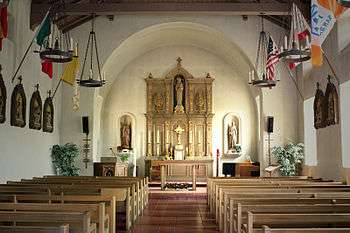Mission San Rafael Arcángel
|
The reconstructed capilla (chapel) of Mission San Rafael Arcángel is to the right of Saint Raphael's Church. | |
 Location of Mission San Rafael Arcángel in California | |
| Location |
1104 5th Avenue San Rafael, California 94901-2916 |
|---|---|
| Coordinates | 37°58′27.5988″N 122°31′40.476″W / 37.974333000°N 122.52791000°WCoordinates: 37°58′27.5988″N 122°31′40.476″W / 37.974333000°N 122.52791000°W |
| Name as founded | La Misión del Gloriosísimo Príncipe San Rafael, Arcángel [1] |
| English translation | The Mission of the Glorious Prince, Archangel Saint Raphael |
| Patron | The Glorious Prince Saint Raphael, Archangel [2] |
| Nickname(s) | "Mission of Bodily Healing" [3] |
| Founding date | December 14, 1817 [4] |
| Founding priest(s) | Father Vicente Francisco de Sarría [5] |
| Military district | Fourth |
| Native place name(s) | 'Anaguani [6] |
| Baptisms | 1,821 [7] |
| Marriages | 519 [7] |
| Burials | 652 [7] |
| Secularized | 1834 [2] |
| Returned to the Church | 1855 [2] |
| Governing body | Roman Catholic Archdiocese of San Francisco |
| Current use | Chapel / Museum |
| Reference no. | 220 |
| Website | |
| http://saintraphael.com | |
Mission San Rafael Arcángel was founded in 1817 as a medical asistencia ("sub-mission") of Mission San Francisco de Asís. It was a hospital to treat sick Native Americans, making it Alta California's first sanitarium.[8] The weather was much better than in San Francisco, which helped the ill get better.[9] It was not intended to be a stand-alone mission, but nevertheless grew and prospered and was granted full mission status on October 19, 1822.
History
Mission San Rafael Arcángel was founded in the present day location of San Rafael, California, on December 14, 1817, by Father Vicente Francisco de Sarría, as a medical asistencia ("sub-mission") of the San Francisco Mission to treat their sick population. It was granted full mission status in 1822.
This was one of the second missions turned over to the Mexican government in 1833 after the Mexican secularization act of 1833. In 1840, there were 150 Indians still at the Mission. By 1844, Mission San Rafael Arcángel had been abandoned; what was left of the empty buildings was sold for $8,000 in 1846. The Mission was used by John C. Fremont as his headquarters during the battles to make California a United States possession (see Bear Flag Revolt).
On June 28th, 1846, three men departed the mission, including Kit Carson, and murdered three unarmed Californians under the order of John C. Fremont; Don José R. Berreyesa, father of José de los Santos Berreyesa, along with the twin sons of Don Francisco de Haro, Ramon and Francisco De Haro. [10]
In 1847, a priest was once again living at the Mission. A new parish church was built near the old chapel ruins in 1861, and, in 1870, the rest of the ruins were removed to make room for the City of San Rafael. All that was left of the Mission was a single pear tree from the old Mission's orchard. It is for this reason that San Rafael is known as the "most obliterated of California's missions." [3]
In 1949, a replica of the chapel was built next to the current Saint Raphael's Church on the site of the original hospital in San Rafael, California.

See also
- Chief Marin
- Mission San Francisco de Asís
- Mission San Francisco Solano
- USNS Mission San Rafael (AO-130) – a Buenaventura Class fleet oiler built during World War II.
Notes
- ↑ Leffingwell, p. 157
- 1 2 3 Krell, p. 295
- 1 2 Ruscin, p. 167
- ↑ Yenne, p. 174
- ↑ Ruscin, p. 196
- ↑ Ruscin, p. 195
- 1 2 3 Krell, p. 315: as of December 31, 1832; information adapted from Engelhardt's Missions and Missionaries of California.
- ↑ Ruscin, p. 169
- ↑ Tays, George (1937). "Mariano G Vallejo and Sonoma". California Historical Society Quarterly. 2. XVI: 109.
- ↑ The Beginnings of San Francisco App. D - The Murder of Berreyesa and the De Haros
References
- Forbes, Alexander (1839). California: A History of Upper and Lower California. Smith, Elder and Co., Cornhill, London.
- Jones, Terry L. and Kathryn A. Klar (eds.) (2007). California Prehistory: Colonization, Culture, and Complexity. Altimira Press, Landham, MD. ISBN 0-7591-0872-2.
- Krell, Dorothy (ed.) (1979). The California Missions: A Pictorial History. Sunset Publishing Corporation, Menlo Park, CA. ISBN 0-376-05172-8.
- Leffingwell, Randy (2005). California Missions and Presidios: The History & Beauty of the Spanish Missions. Voyageur Press, Inc., Stillwater, MN. ISBN 0-89658-492-5.
- Paddison, Joshua (ed.) (1999). A World Transformed: Firsthand Accounts of California Before the Gold Rush. Heyday Books, Berkeley, CA. ISBN 1-890771-13-9.
- Ruscin, Terry (1999). Mission Memoirs. Sunbelt Publications, San Diego, CA. ISBN 0-932653-30-8.
- Yenne, Bill (2004). The Missions of California. Thunder Bay Press, San Diego, CA. ISBN 1-59223-319-8.
External links
- Early photographs, sketches, land surveys of Mission San Rafael Arcángel, via Calisphere, California Digital Library
- A historical drawing of the mission at the Bancroft Library
- Howser, Huell (December 8, 2000). "California Missions (107)". California Missions. Chapman University Huell Howser Archive.
| Wikimedia Commons has media related to Mission San Rafael Arcángel. |
